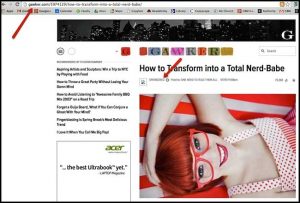True, there are dozens of options and lists of recommended PPC-based ad networks. But how do you choose the one (or ones) that are right for YOUR website? What criteria should you consider?
So you’ve done your research, found the top paying ad networks according to reviews, and now you have to choose which ones to deploy across your online real estate. Comprehensive guides on how to choose from all these options are rare. So many publishers just default to AdSense as a single source of revenue from unsold inventory.
Fortunately for you, that’s one of the reasons we’re here. To help you make the strategic choices that will make you the highest revenues from your content.

How to choose a CPC ad network
1. High CPCs & RPMs
That’s a no-brainer. You want to be paid more so you can grow your business and pay your bills. Like everyone else. So you want those high paying networks so each click brings in more dinero.
But how do you compare? There are two ways. One is to research like crazy. You already have the list of networks, and you can use Google to scout message boards and blogs discussing the profitability of ad networks and comparing them.
Another way, and the one we recommend, is mixing and matching. You can dedicate portions of your unsold inventory to different ad networks and compare results so you can choose the best one.
You might think the commission percentage the ad network charges advertisers has an adverse effect on RPMs. It usually doesn’t. Some ad networks do charge advertisers significantly more than they pay you, but they also invest in optimization algorithms and have advertisers that will bring more clicks. So while CPCs might be lower there, overall performance might be in your favor.
2. Reliability and credibility
You don’t want to do business with an unreliable source of revenue. No one does. This is where you need to get dirty again and do research. Make sure there are people out there that really got paid for their traffic by your ad network of choice.Big companies like Google and BidVertiser are of course reliable, but small obscure ones? While potentially they can be a source of high CPCs and RPMs, they might also be shady and post ads on your page that lead to malware infested cesspits of the internet.
Also, don’t forget to check the payment terms of the ad networks you’re evaluating. NET 90 payment terms can put a stress on your income column for the first few months.
3. Advertiser geo matching traffic/content geo
Obviously, you want your choice ad networks to have ads for your target audience locales. This is easy if the majority of your traffic comes from a single country or state. But what happens if you have audiences from multiple locales or a multilingual site? In that case, you need pick a display ad network that can target audiences in different geos.
4. Audience targeting
Much like geo-targeting, ads on your page need to relate to your audience. Content targeting is all good and nice (when it works), but you want ad networks that offer click-worthy ads to YOUR visitors.
So if you have a niche blog, you may want to seek out a vertical ad network that works with advertisers relevant to the interests of your readers. If you have a site that attracts audiences you segment (like sports fans, online shoppers, technology geeks), look for ad networks that support that. Advertisers will always pay more for well-targeted placement. And users will click it more. And everyone is happy.
5. Reporting
Seeing those dollars in the bank is great. Truly, one of the best feelings for a publisher. But since we like to make as much as we can, it’s important to optimize. And for optimization, you need data. And for data you need reporting capabilities.
The more information you get from the ad network, the more you can do with it. For example, you can contact well-performing advertisers directly and offer a premium deal. If this information is not available to you, you can still compare the performance of various ad sizes, formats, locations and themes.
6. Technical compatibility & ease of deployment
If it don’t fit, it won’t work. If it takes more time and effort to deploy an ad network setup than it’s worth in monetary terms? It’s a loss. Especially if you consider our recommendation to try and compare performance across networks.
If you use an ad server, make sure the ad network can work smoothly with it. If you use a CMS like WordPress, look for a plugin.
7. Customization & flexibility
We each have our needs and habits. Being able to adjust the settings to match your requirements is important. A variety of ad formats, sizes and niches can help you find the sweet spots that bring in high-CPC clicks.
And as many a divorcee will tell you – needs tend to change. Suddenly, you might want to shift from a mobile website to an app. This means you’ll need an ad network to support that, or you’ll have to set up a whole separate ad stack and server for your mobile app.
8. Ease-of-use
You want an ad network that is easy to work with. A user interface that won’t confuse you, an API that is easy to set up wherever needed and a work interface with support and customer service. These are all crucial components in your relationship with a source of revenue.
9. Control
As a publisher, you want to have at least some measure of control over what is advertised on your online property. And how much you earn from it.
Check that the CPC ad network of your choice lets you block your competitors from advertising on your site and collecting data on your hard-earned viewers.
Advertiser blocking isn’t just for keeping competition from stealing your audience. It’s also important to prevent advertiser migration. If your direct deals see they can get a better deal on an ad network you use – you’re in trouble.
10. User experience
To make money, you need your audience to keep coming and clicking. They won’t do that if the ads displayed are intrusive, offensive or annoying.
When picking an ad network, you need to make sure it has a good system for filtering out ads by category and a moderation team that does its job. Otherwise, you might end up advertising vibrators with animations to religious old men. Some might like, but some might really not.
11. Speed
Another thing that can adversely affect user experience is site loading speed. We discussed the reasons for loading delays, their cost and methods for prevention is a blog post recently. When testing an ad network, it’s important to keep an eye on site load speeds in all the geos your audience is located in.

A CPC Network is not a Catholic Wedding
Keep in mind that you can always change your mind. If the advertising network you’re using for your unsold inventory isn’t paying enough – just switch. Or try optimizing and A/B testing between two or more ad networks on your site. Just keep in mind that you don’t want to have too many ads on your pages, so be patient.
Digital & Social Articles on Business 2 Community(54)
Report Post






